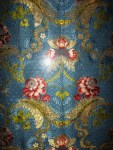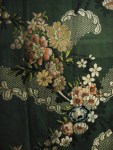I have to admit it–your average 22-year-old wouldn’t jump up and down with glee when she found, in a museum, an enormous stock of textiles from all ages of history. Not being exactly “average”, I got a little giddy.
I didn’t realize that the Victoria & Albert Museum had such a lovely collection of textiles on display. Upstairs on the third (ie fourth to Americans) floor, just beside the Europe and American 19th century room, there is a place of  splendor. The long, thin room is filled with rows of textile samples. They work a bit like library stacks. There are rows, and slotted into each row is an upright wooden frame with a textile sample. Each one is numbered for reference and has a label for more detail.
splendor. The long, thin room is filled with rows of textile samples. They work a bit like library stacks. There are rows, and slotted into each row is an upright wooden frame with a textile sample. Each one is numbered for reference and has a label for more detail.
The textiles included come from all over the world and are as old as the 14th century (perhaps earlier–that is the earliest date I recall seeing).
My first thought was: Nicole! There are few things are lovely as 18th-century dress and textile. There were some very pretty lace and printed cotton samples. The lace is impressive mostly because of the work put into it. I found the cotton prints interesting because they all seemed to be on a white background. I probably could have spent hours going through that place, admiring the beauty of it all. I went through, tugging things partially at random. I didn’t mind what I pulled out, because it was all impressive.
Near the end of my time, I found exactly what I was looking for: some exquisite cloth of exactly the type I can see the ladies of the Affair of the Diamond Necklace wearing. I thought particularly of Nicole, of course, as she is the main character of my work-in-progress. I took some pictures for reference of my favorite ones. The result was not an unmitigated success since the room was dim. However, I think I managed to get an idea of the beauty and the color of these fantastic textiles. I wish I could share some technical details with you, but the photos I took of the information cards all turned out blurry and unreadable. Next time I stop by the V&A (and let’s face it, I’m going to go back sometime soon), I’ll try to get the little details. Until then, enjoy the beauty:
-

-

-
Richly brocaded silk, French 1750-55. Woven in tabby, brocaded in silk and metal thread. The flush pattern in the field is created by a blue pattern weft.
-

-

-
Brocaded silk, French 1770’s. Tabby weave, brocaded in colored silk. The lacey pattern distracts from the lines of flowers., a common design in the 3rd quarter of the 18th century.
-











